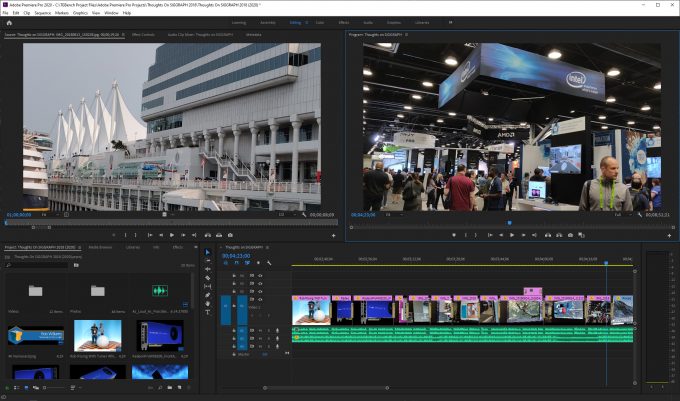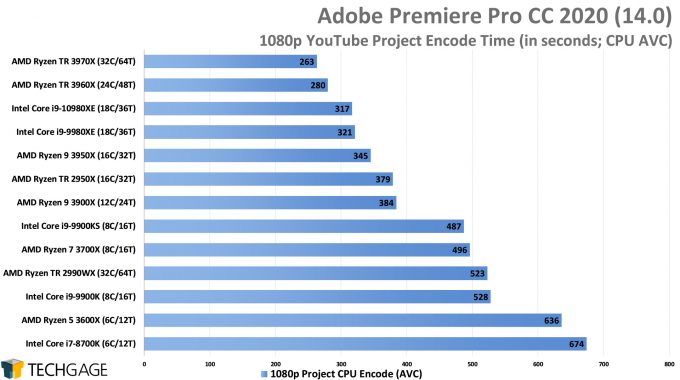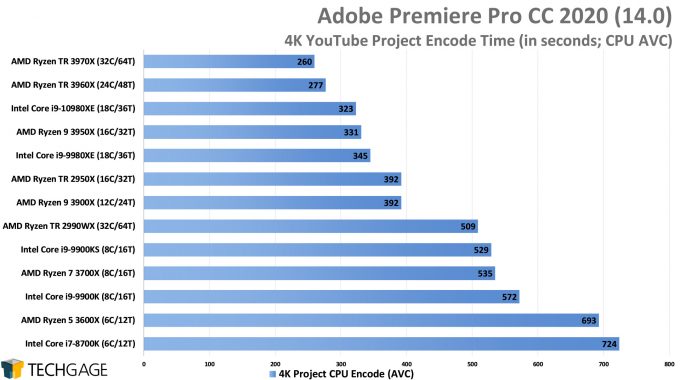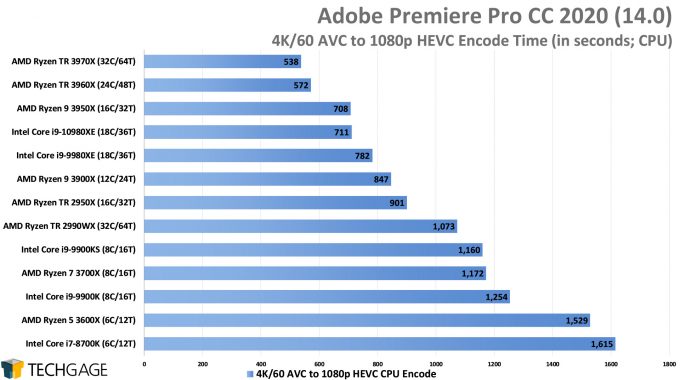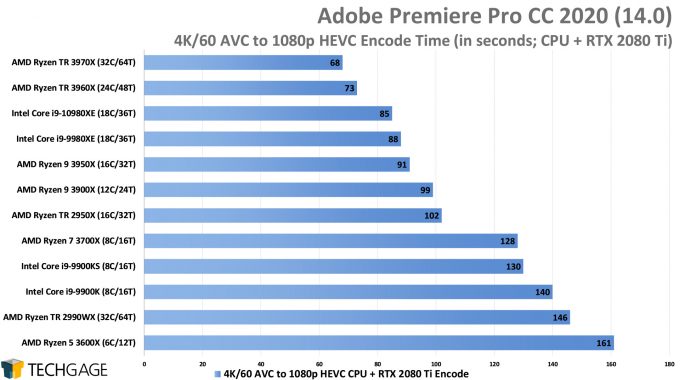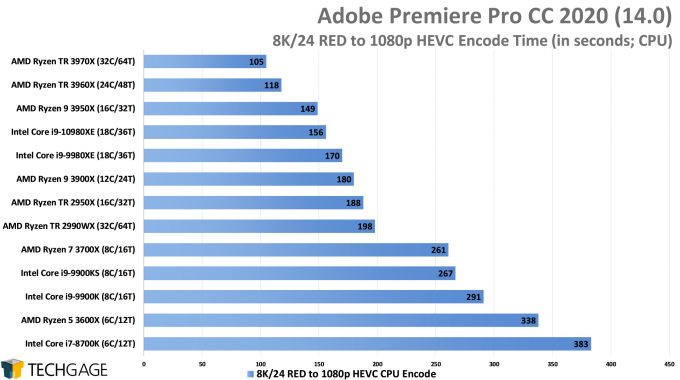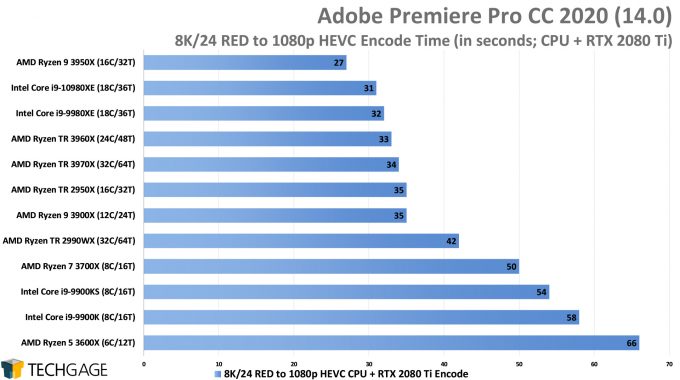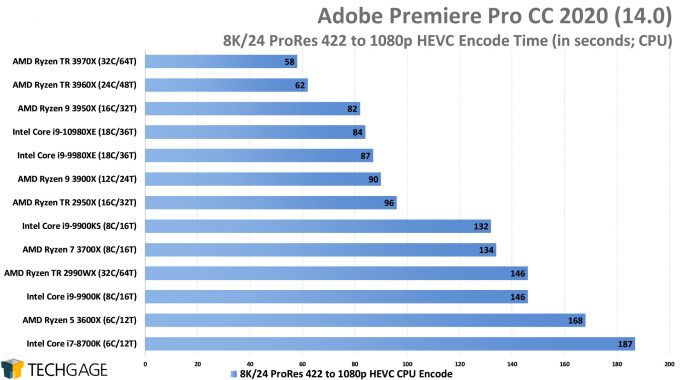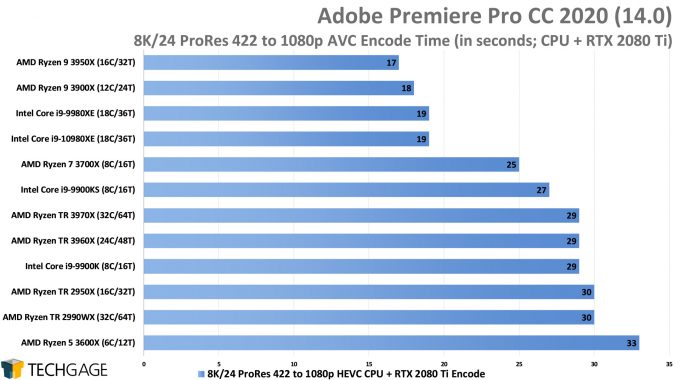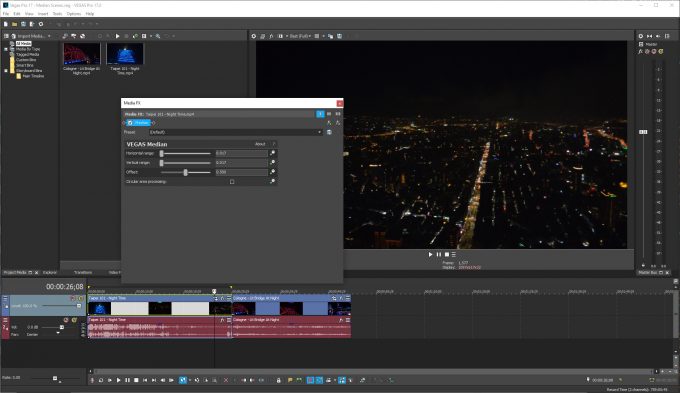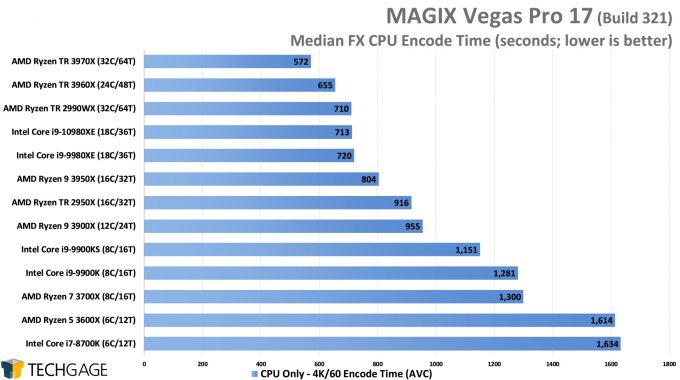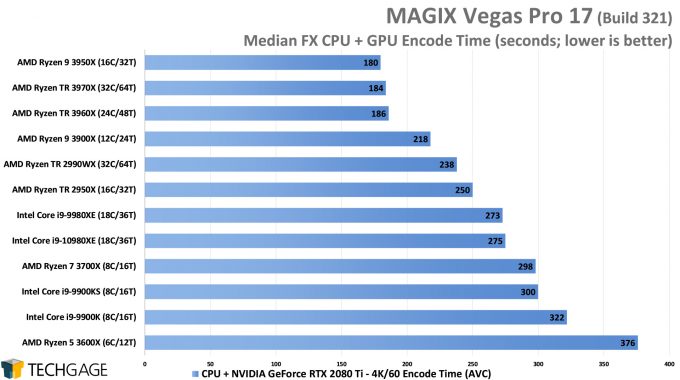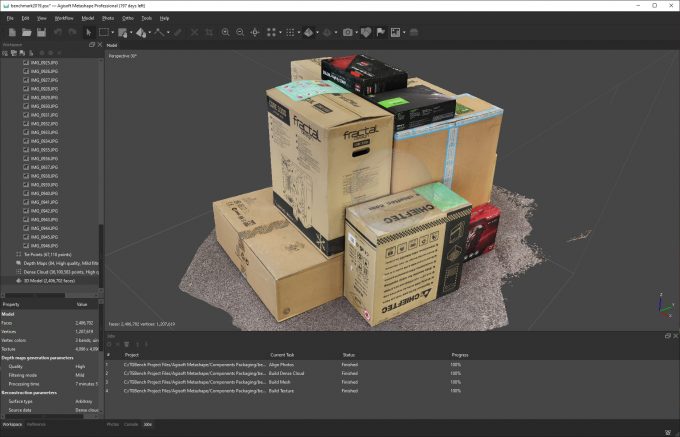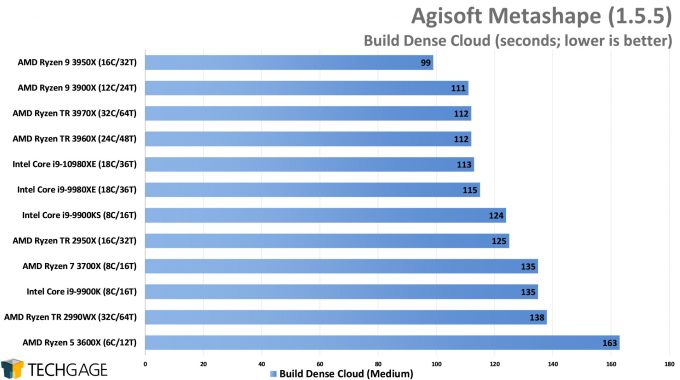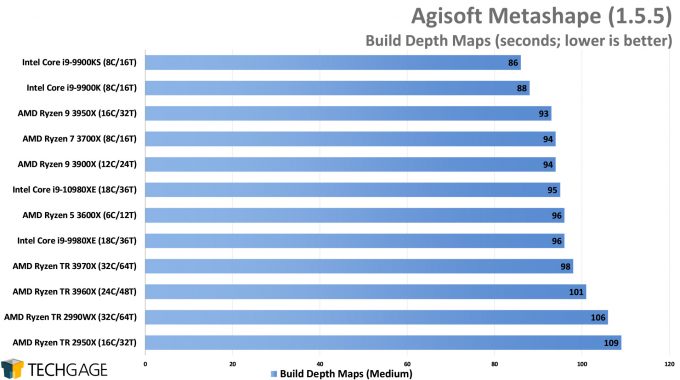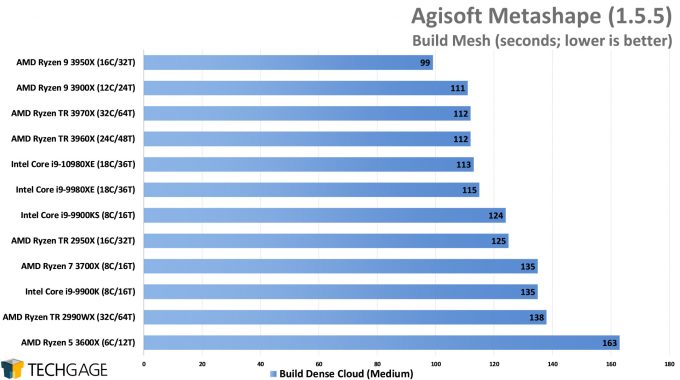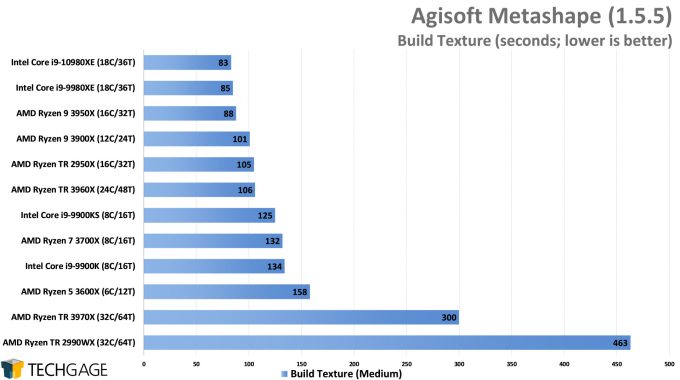- Qualcomm Launches Snapdragon 4 Gen 2 Mobile Platform
- AMD Launches Ryzen PRO 7000 Series Mobile & Desktop Platform
- Intel Launches Sleek Single-Slot Arc Pro A60 Workstation Graphics Card
- NVIDIA Announces Latest Ada Lovelace Additions: GeForce RTX 4060 Ti & RTX 4060
- Maxon Redshift With AMD Radeon GPU Rendering Support Now Available
A Real HEDT CPU: AMD Ryzen Threadripper 3960X & 3970X Workstation Performance Review
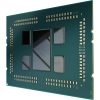
We’ve already put AMD’s newest Ryzen Threadripper chips through our Linux test gauntlet, so it’s now time to shift our focus back to Windows, where we have an even more daunting number of tests to cover. It won’t take long to notice a trend: AMD’s 24-core 3960X and 32-core 3970X are ridiculously fast processors.
Page 3 – Encoding: Premiere Pro, Vegas Pro & Agisoft Metashape
We’re going to kick off this performance look with a handful of encode tests. Encoding is one of those scenarios that can be extremely hit-or-miss when it comes to taking good advantage of big CPUs. Sometimes, applications will give the impression that they’re making proper use of the CPU, but we’ve found more than once that some applications actually just use the entire CPU very poorly.
Fortunately, the situation is getting a lot better over time. As an example, for most of its life, Adobe’s Lightroom didn’t use more than a few cores and threads. Today, the application can use most of whatever CPU you can hand it.
The performance look on this page is going to tackle Adobe’s ever-popular Premiere Pro, as well as MAGIX’s Vegas Pro. That duo takes care of video encoding for this page, while Agisoft’s Metashape will help with a photogrammetry scenario.
Adobe Premiere Pro CC – CPU
From the get-go, AMD’s new Threadrippers impress. There isn’t too much to say that isn’t obvious when the products we’re looking at are glued to the top, but it’s important to at least pay attention to the generational gains in performance between the new and old 32-core Threadrippers. The last-gen 2990WX (and siblings) had a design that didn’t jive with certain different workloads, but especially encoding.
This is the first bit of proof we can see that the new Threadrippers really do fix the problem with NUMA modes that plagued the last generation. This is the kind of performance scaling we hoped for, but weren’t sure we’d get. How about some codec tests where the GPU makes an entrance?
Adobe Premiere Pro CC – Codec Comparisons
We’re going to see some variations with the results below, so let’s start here with the AVC to HEVC tests above. In both of these, the scaling from our initial project tests carries over here, with both of the new Threadrippers keeping pegged to the top. That continues once the GPU is involved, resulting in dramatically improved overall encode times, regardless of the CPU involved.
Things shake up a wee bit with RED:
In this RED transcode, the CPU only encode mode bodes (sorry) well for the new 24- and 32-core. With the GPU added in, scaling changes up a fair bit, although it’s hard for us to get a read on what makes for the most perfect blend of CPU processing + GPU processing. The 16-core 3950X soared to the top here, taking seconds off of the previous encode time. It could be that RED prefers high clocks and a bunch of cores rather than more modest clocks with many more cores. Either way, this is what we go. How does ProRes change things up?
With these ProRes results, we can see that the 3950X domination when joined by a GPU carries over to this ProRes test. Interestingly, the new Threadrippers fall a fair bit back of Intel here (with the GPU involved), something we hope to see improved in the future, especially as software developers begin paying more attention to not only AMD, but properly threading for so many cores.
MAGIX Vegas
In Premiere Pro, we saw that the new Threadrippers could fall behind some other competition once the GPU is introduced, and (perhaps not so) surprisingly, we’re seeing similar things here. The 3950X yet again places on top of the GPU test, though it’s not as though it’s running that far ahead of the Threadrippers behind it. Since we do see good scaling between 3900X and 3950X, it could be that this is another case of where optimization would improve scaling – or our test project just isn’t demanding enough (but we think it is, as the Median FX filter is seriously computationally intensive).
What we haven’t tested though, is the impact of lower-end GPUs with encoding tasks, since not everyone will have an RTX 2080 Ti to throw into a workstation. Under such workloads, the core counts of the CPU may factor in more. However, at this point we haven’t had the time to fully explore this, and may be something we get a chance to look at later.
Agisoft Metashape
Metashape is a fun application to test with, but its performance results are rather unpredictable at times. And, because a singular process actually encompasses multiple different workloads, the CPU and GPU will be used differently throughout. That’s why a breakdown like this is important, to see which tasks each CPU is good at.
Ultimately, for everything but the Build Texture phase, Metashape really seems to love processors that sport big clock speeds, and a healthy amount of cores. Adding more cores to your Metashape problem isn’t the solution, but for the sake of erring on the side of caution, your Metashape workload may scale a bit differently than ours.
We also have an aerial project we’ve been contemplating adding to our suite, but the amount of time it takes to run is rather prohibitive at the moment. Our test suite already takes 10 straight hours to get through on the fastest chip we have – so we need to begin optimizing before adding more! That said, we have been working on adding RealityCapture, as well, but still have to perfect our test scripts.
Support our efforts! With ad revenue at an all-time low for written websites, we're relying more than ever on reader support to help us continue putting so much effort into this type of content. You can support us by becoming a Patron, or by using our Amazon shopping affiliate links listed through our articles. Thanks for your support!




